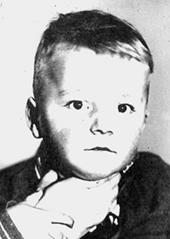Search for Names, Places and Biographies
Already layed Stumbling Stones
Suche
Günther Fitschen * 1933
Winsener Straße 19 (Harburg, Wilstorf)
HIER WOHNTE
GÜNTHER FITSCHEN
JG. 1933
EINGEWIESEN18.5.1937
ALSTERDORFER ANSTALTEN
"VERLEGT" 10.8.1943
HEILANSTALT MAINKOFEN
ERMORDET 29.4.1945
Günther Fitschen, born on 15 July 1933 in Harburg-Wilhelmsburg, admitted to the "Alsterdorf Asylum” ("Alsterdorfer Anstalten ") on 18 May 1937, "transferred” to the "Mainkofen sanatorium and nursing home” ("Heil- und Pflegeanstalt Mainkofen”) on 10 Aug. 1943, murdered on 29 Apr. 1945
Wilstorf quarter, Winsener Strasse 19
Günther-Bernhard Rudolf Fitschen was born as the illegitimate child of his mother Margarethe Fitschen (born on 24 May 1913). Five weeks after his birth, she married the worker Otto Marsal (born on 26 Aug. 1908), who was not the biological father of the boy.
Margarethe Marsal found things difficult in her new role as wife and young mother. The youth welfare office soon took care of the little boy’s wellbeing and arranged for the child to be cared for additionally by the Protestant Margarethenhort, a daycare center on Nöldekestrasse, and the Catholic Vincenzheim, a children’s home on Reeseberg.
In the following weeks and months, it became apparent that Günther Fitschen did not develop according to his age. After an in-depth medical examination of the boy in Jan. 1937, the municipal welfare office decided to entrust him to a psychiatric institution. On 15 July 1937, the Alsterdorf Asylum took Günther Fitschen into their care. During the initial examination, Gerhard Kreyenberg, the managing senior physician in charge of this institution, found that the almost four-year-old boy was unable to walk and speak. In his diagnosis, he concluded that the young patient suffered from congenital mental "feeblemindedness” ("Schwachsinn”) and deaf-muteness.
In the following weeks and months, hardly any progress in his health could be observed. The young patient spent most of his time lying on his back and occasionally made careful attempts to walk. He was still dependent on additional help for personal hygiene and food intake. He was pleased when he could seize objects handed to him, but then mostly left them unused on the spot because he had no use for them.
For a long time Günther Fitschen was described as friendly and apparently, he learned to walk. The assessment changed abruptly in the spring of 1943. At this point, the patient file read, "Patient ranks very low; he cannot occupy himself at all, running through the department rooms without a plan the whole day. Lately, he has been starting to rip his stuff apart, and he has also been beating with his feet against all objects, or himself in the face with his fist, which often gives him bruises. He needs to be dressed, washed, and fed.”
During the Nazi era, the Alsterdorf Asylum was deeply entangled in the practice of Nazi health and social policy. Pastor Friedrich Karl Lensch, the head of the institution, and the managing senior physician Gerhard Kreyenberg, both members of the Nazi party (NSDAP), acted as staunch advocates of a theory that divided humanity into valuable and worthless living beings. Curative education approaches in the treatment of the sick, which had become increasingly important after the First World War, were replaced by technological and laboratory medicine after 1933. Gerhard Kreyenberg transformed the facility into a special hospital for the treatment of all kinds of mental defects. Those he was unable to heal had forfeited their right to life in his eyes.
Both Kreyenberg and Lensch welcomed the Nazi "Law for the Prevention of Offspring with Hereditary Diseases” ("Gesetz zur Verhütung erbkranken Nachwuchses”) dating from July 1933 on as a courageous step in the right direction. At least 231 patients of the Alsterdorf Asylum were forcibly sterilized during the Nazi period because they were considered "genetically inferior” ("erbbiologisch minderwertig”). In 1938, Lensch and Kreyenberg ordered the deportation of all Jewish residents of this Christian institution to state institutions.
When in 1940, all sanatoriums and nursing homes were asked to prepare registration forms for their inmates, Pastor Lensch did not need any arm-twisting, although he knew that the forms would serve as a basis for the deportations that would soon begin. Between 1938 and 1943, 629 persons overall were taken from Alsterdorf to "euthanasia” killing centers.
One of them was Günther Fitschen. On 10 Aug. 1943 he was "transferred” together with 112 other boys and men to the "Mainkofen sanatorium and nursing home” in Bavaria. These patients, too, were particularly difficult, care-intensive institutional inmates, and, as it was formulated in the institutional language at the time, they were "low-ranking patients.”
They arrived at their destination two days later. Starting in Dec. 1942, a decree of the Bavarian State Ministry applied there with the order that "both quantitatively and qualitatively those inmates ... who perform useful work or are undergoing therapeutic treatment ... are better cared for at the expense of the other inmates.”
This "starvation diet” ("Hungerkost”) was responsible to a considerable extent for the deplorable record of deaths in Mainkofen in those years. Of the 113 Alsterdorf patients, only 39 were still alive at the end of 1945. Günther Fitschen was not one of them.
He died on 29 Apr. 1945, as his mother later learned.
Translator: Erwin Fink
Kindly supported by the Hermann Reemtsma Stiftung, Hamburg.
Stand: June 2020
© Klaus Möller
Quellen: Harald Jenner, Michael Wunder, Hamburger Gedenkbuch Euthanasie. Die Toten 1939–1945, Hamburg 2017; Archiv der Evangelischen Stiftung Alsterdorf, Patientenakte V 418; Michael Wunder, Ingrid Genkel, Harald Jenner, Auf dieser schiefen Ebene gibt es kein Halten mehr. Die Alsterdorfer Anstalten im Nationalsozialismus, Hamburg 1987; Michael Cranach, Hans-Ludwig Siemen, Psychiatrie im Nationalsozialismus. Die Bayerischen Heil- und Pflegeanstalten zwischen 1933 und 1945, München 1999; Herbert Diercks, `Euthanasie´. Die Morde an Menschen mit Behinderungen und psychischen Erkrankungen in Hamburg im Nationalsozialismus, Hamburg 2014; Harburger Adressbücher.


